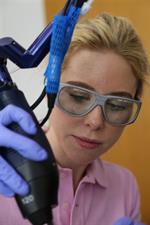Results from first clinical trial shows improvement with ablative fractional skin resurfacing.
Wausau, WI (January 2, 2019) – Fractional ablative resurfacing is frequently used for treating atrophic and acne scars as well as for the early improvement of scars after surgery. No evidence‐based clinical data on improving the appearance of skin grafts by fractional CO2‐laser resurfacing has been available so far. The objective of this study was to assess the efficacy of fractional CO2-laser treatment to improve the cosmetic outcome of skin grafts.
The clinical report of this study, published in Lasers in Surgery and Medicine (LSM), the official journal of the American Society for Laser Medicine and Surgery, Inc. (ASLMS), was selected as Editor’s Choice in the December 2018 issue of LSM.
The study, led by Elisabeth Datz, MD, is titled “Fractional Carbon Dioxide Laser Resurfacing of Skin Grafts: Long-Term Results of a Prospective, Randomised, Split-Scar Evaluator-Blinded Study.”
Two independent investigators evaluated adaptation of treated and non-treated sides of skin grafts to the surrounding skin on an 11-point scale. Pigmentation, resizing and roughness of skin grafts were also objectively measured as well as patient satisfaction with the cosmetic result. Two treatments with the fractional CO2-laser had significantly improved adaptation to the surrounding skin in comparison to untreated controls 8 weeks, 6 and 12 months after the two treatments.

“No evidence-based clinical data on improving the appearance of skin grafts by fractional CO2- laser resurfacing have been available so far,” said Datz. “This is the first clinical trial that has shown that adaptation of the skin graft to the surrounding skin can be significantly improved with ablative fractional skin resurfacing. Patient satisfaction with the appearance of the skin graft is also significantly higher after graft resurfacing. Thus, fractional skin resurfacing can be recommended for patients wishing to improve the appearance of their skin graft.”
Elisabeth Datz, MD, studied medicine at the University of Regensburg, from which she graduated with magna cum laude. In 2012, she completed a five-year residency at the Department of Dermatology of the University Medical Center Regensburg. She conducted several clinical trials on photodynamic therapy and laser therapy in dermatology. Her special interests are fractional laser skin rejuvenation, photodynamic therapy and tumor metabolism. Besides her current activity as a dermatologist in a private practice in Tübingen, she continues her research activities at the Department of Dermatology of the University Medical Center Regensburg.
Editor’s Choice is an exclusive article published in LSM, the official journal of the ASLMS. View the complete manuscript.
The American Society for Laser Medicine and Surgery, Inc. (ASLMS) is the largest multi-disciplinary professional organization, dedicated to the development and application of lasers and related technology for health care applications. ASLMS promotes excellence in patient care by advancing biomedical application of lasers and other related technologies worldwide. Currently, ASLMS has over 3,500 members, including physicians and surgeons representing multiple specialties, physicists involved in product development, biomedical engineers, biologists, nurses, industry representatives and manufacturers. For more information, visit aslms.org.